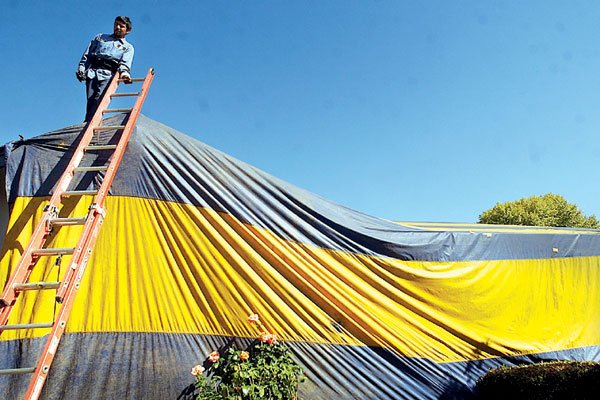They look like a Cirque du Soleil production, with that certain
aura of mystery in the scene that seems, by turns, part Barnum
&
amp; Bailey, part Ripley’s Believe It Or Not. Homes wrapped in
striped plastic like giant Christmas presents tend to inspire fear
in nearby neighbors and bravado-filled curiosity in area children,
but according to industry experts, the process of tenting a home is
both a simple and very normal occurrence.
They look like a Cirque du Soleil production, with that certain aura of mystery in the scene that seems, by turns, part Barnum & Bailey, part Ripley’s Believe It Or Not. Homes wrapped in striped plastic like giant Christmas presents tend to inspire fear in nearby neighbors and bravado-filled curiosity in area children, but according to industry experts, the process of tenting a home is both a simple and very normal occurrence.
As David Clare, a branch manager for South Bay’s Terminix, said, “When you own a home or another structure, at some point you’re going to have to fumigate.”
Tenting is a specialized business with few true contractors and a long history. Workers are required to be certified by the state, and generally use the most sophisticated equipment available, though they’re not in much danger of falling behind the times. The gas in use today has been the standard industry tool for more than 40 years, and despite some negative or frightening portrayals in television – such as a recent episode of CBS’s hit crime drama CSI – large-scale fumigation companies do thousands of successful treatments per year with little incident.
Several pest control agencies in the South Valley subcontract their work to one company: Mission City Fumigation. The Santa Barbara-based contractor extends its reach from the Bay Area to Los Angeles, and owner Bob Howell is also president of the Pest Control Operators of California.
“CBS actually used our equipment,” said Ed Hernandez, a regional manager for the company. “There have been very few incidents related to the product, but just like any other (television) program that deals with cops or doctors, there is some degree of accuracy mixed with fantasy. It’s not going to stop you from calling the police if something’s wrong.”
And something is definitely wrong if your house requires tenting. Drywood termites, a type of colony that lives in the wood of a home and emerges yearly for mating, are among the most costly pests in the world. Not only do they attack the most significant investment that most Americans make, the structural damage they cause each year exceeds that of earthquakes, floods and fires combined.
“Termites don’t sleep,” said Clare. “It’s like finding cancer. It’s not something where you’re going to want to put off getting
treatment for very long because it will just get worse.”
The fumigation process is relatively short – three days for most termites or five for wood-boring beetles, which only account for 2 to 5 percent of the local fumigation market, said Hernandez – but does require a significant amount of prep work by the home owner. The gas used in fumigation is designed to penetrate paint, drywall, wood and just about anything else except plastic and water. It’s also a biocide, meaning anything that’s living in the house will be extinct when the tarps come down.
Owners not only need to move their plants and animals, but also a long list of perishable foods, cosmetics and screw-capped liquids. Basically, anything that is not in a “factory-sealed glass, plastic or metal container” must go along with satellite dishes, television antennas, connecting fences, and shrubbery within six to 12 inches of the home.
“You want to have a close fit,” said Hernandez. “That’s how you know it’s a nice wrap. If you’ve got huge bulges or flaps it’s wasted space. You want it to look just like a Christmas package.”
Achieving that tight fit is not always as easy as it looks. The average tarp weighs 150 pounds and measures 43×65 feet. Dirt is used as the primary filler where a tight seal cannot be achieved, and the ground near the home is thoroughly doused to ensure that little of the gas escapes through the soil. Inside the house, workers set up lines and fans to ensure that the colorless, odorless fumigant, tinged with a bit of tear gas as a warning agent, continues to circulate properly.
“The amount is calculated based on the temperature, the size of the house, wind conditions, type of tarps you’re using and the seal you’ve gotten around the house … basically it’s a pretty complicated equation,” said Clare.
Homeowners are locked out for the fumigation process just like anyone else.
“We secure the house with secondary locks,” said Clare. “We post signs telling people that the house is being fumigated. We even hold the key so that even the homeowner could not break in if they wanted to.”
After the tents come down, the gas disperses into the air relatively quickly and the home is left to continue airing out for six to 12 hours, until fumigant concentrations reach five parts per million or less.
“This is a judicious application,” said Hernandez. “It’s just like a scalpel. You put this in the hands of an idiot, and he’ll cut you up. But in the hands of a surgeon? He’ll fix you up so you’ll never even know you had the problem.”
Termites
vs.
Ants
Destructive dry-wood termites drop small pellets of partially digested wood that look almost like sand, but so do carpenter ants.
Termites swarm, generally between April and August, but so do carpenter ants. So how do you tell if your home might need serious help?
Ants, which don’t require house tenting to eradicate, have a very segmented body, clearly split into head, thorax and abdomen sections.
Termites appear to have one long oval-shaped body. They also have four wings of identical length whereas ants have one set of wings that is larger than the other. However, the diagnosis is something that is not best left to chance.
Call a professional to come look at your home if you suspect an active termite infestation. Even if you don’t decide to use professional services, a qualified inspector is required to provide you with a copy of the findings and recommendations within 10 days.













